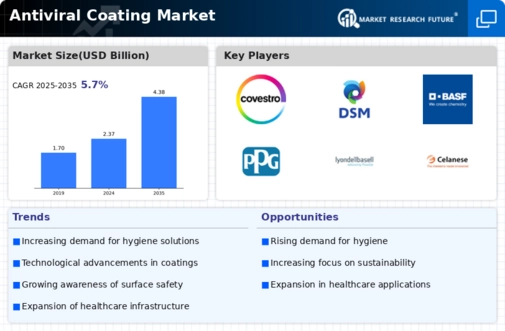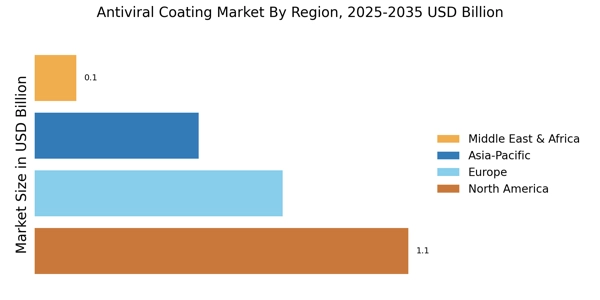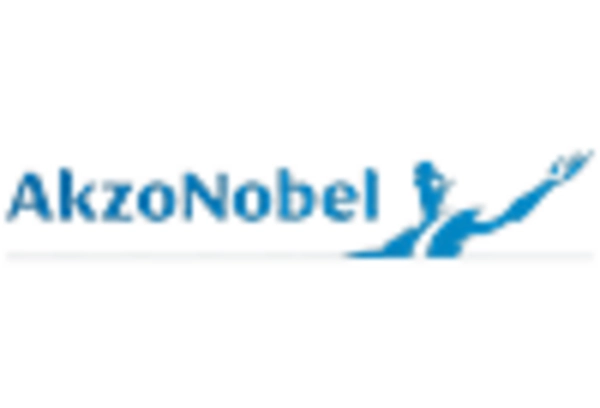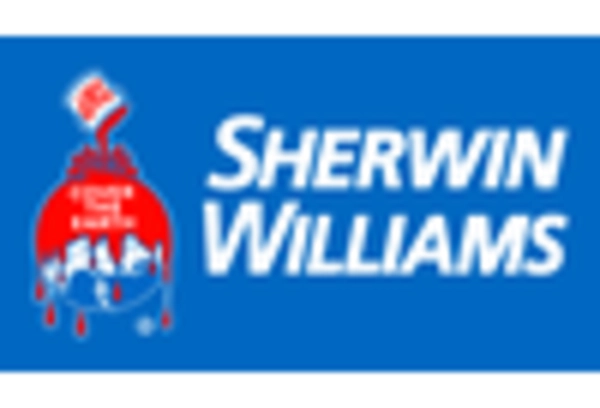Expansion of End-Use Industries
The expansion of end-use industries is playing a pivotal role in shaping the Antiviral Coating Market. Sectors such as construction, automotive, and consumer goods are increasingly incorporating antiviral coatings into their products to enhance safety and appeal to health-conscious consumers. This trend is particularly pronounced in the construction industry, where the demand for antimicrobial surfaces is on the rise. Market projections indicate that the construction sector alone could account for a significant portion of the antiviral coating market, with an expected growth rate of 9% over the next few years. As more industries recognize the value of antiviral coatings, the overall market is likely to experience robust growth, driven by diverse applications and increased consumer demand.
Rising Demand for Hygiene Solutions
The increasing emphasis on hygiene and cleanliness across various sectors appears to be a primary driver for the Antiviral Coating Market. As consumers and businesses alike prioritize health and safety, the demand for antiviral coatings is likely to surge. This trend is particularly evident in healthcare facilities, public transportation, and educational institutions, where the need for protective surfaces is paramount. Market data suggests that the antiviral coating segment is projected to grow at a compound annual growth rate of approximately 10% over the next five years. This growth is indicative of a broader shift towards incorporating advanced materials that offer enhanced protection against pathogens, thereby reinforcing the importance of antiviral coatings in everyday environments.
Growing Awareness of Infectious Diseases
Growing awareness of infectious diseases among the general public is a significant driver for the Antiviral Coating Market. As individuals become more informed about the transmission of viruses and the importance of preventive measures, the demand for antiviral coatings is likely to increase. This heightened awareness is particularly relevant in sectors such as hospitality, retail, and education, where the risk of infection can be higher. Market analysis indicates that the rising concern over health and safety is expected to contribute to a substantial increase in the adoption of antiviral coatings. This trend suggests that manufacturers who effectively communicate the benefits of their products may capture a larger share of the market, further driving growth.
Technological Advancements in Coating Materials
Technological advancements in coating materials are significantly influencing the Antiviral Coating Market. Innovations in nanotechnology and polymer science have led to the development of more effective antiviral coatings that can be applied to a variety of surfaces. These advancements not only enhance the efficacy of the coatings but also improve their durability and application methods. For instance, the introduction of self-cleaning and long-lasting coatings is expected to drive market growth. As manufacturers continue to invest in research and development, the market is likely to witness the emergence of novel products that meet the evolving needs of consumers and industries. This trend suggests a robust future for antiviral coatings, with potential market expansion driven by continuous innovation.
Increased Regulatory Support for Health Standards
Increased regulatory support for health standards is emerging as a crucial driver for the Antiviral Coating Market. Governments and health organizations are implementing stricter regulations regarding hygiene and safety in public spaces, which is likely to propel the demand for antiviral coatings. Compliance with these regulations often necessitates the use of advanced materials that can effectively mitigate the spread of viruses and bacteria. As a result, manufacturers are compelled to adopt antiviral coatings to meet these standards, thereby expanding their market presence. The anticipated growth in regulatory frameworks is expected to create a favorable environment for the antiviral coating sector, potentially leading to a market growth rate of around 8% annually over the next few years.


















Leave a Comment